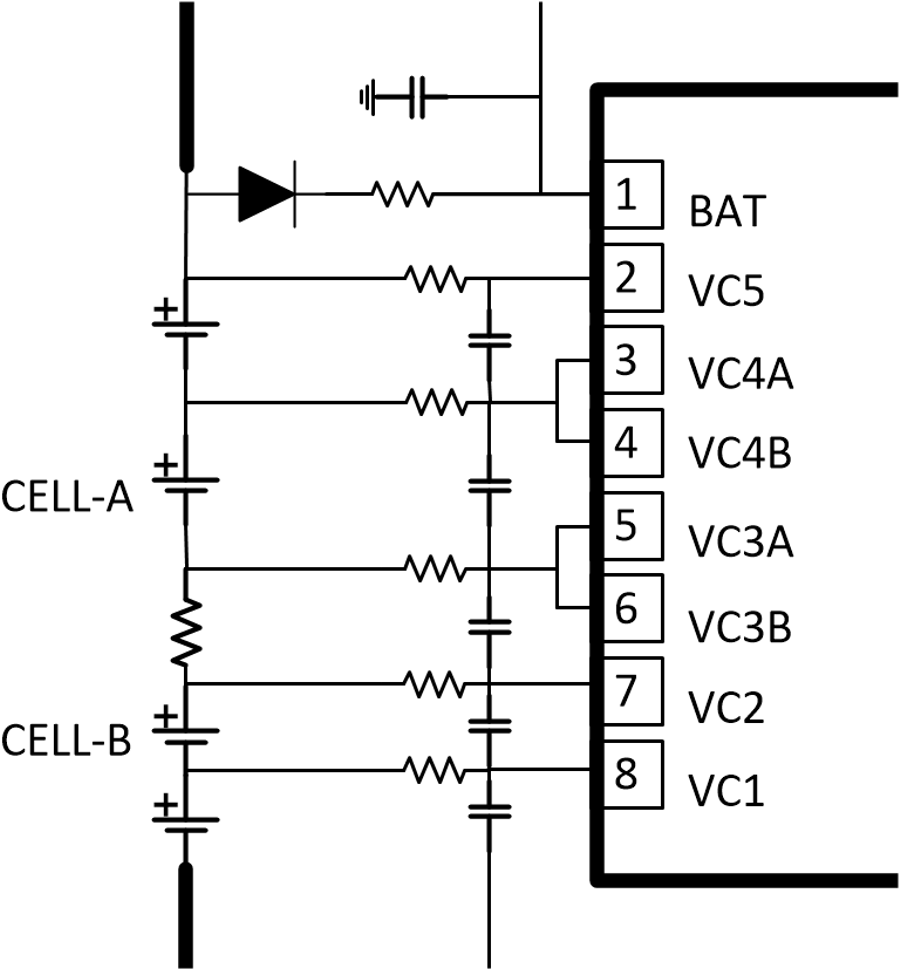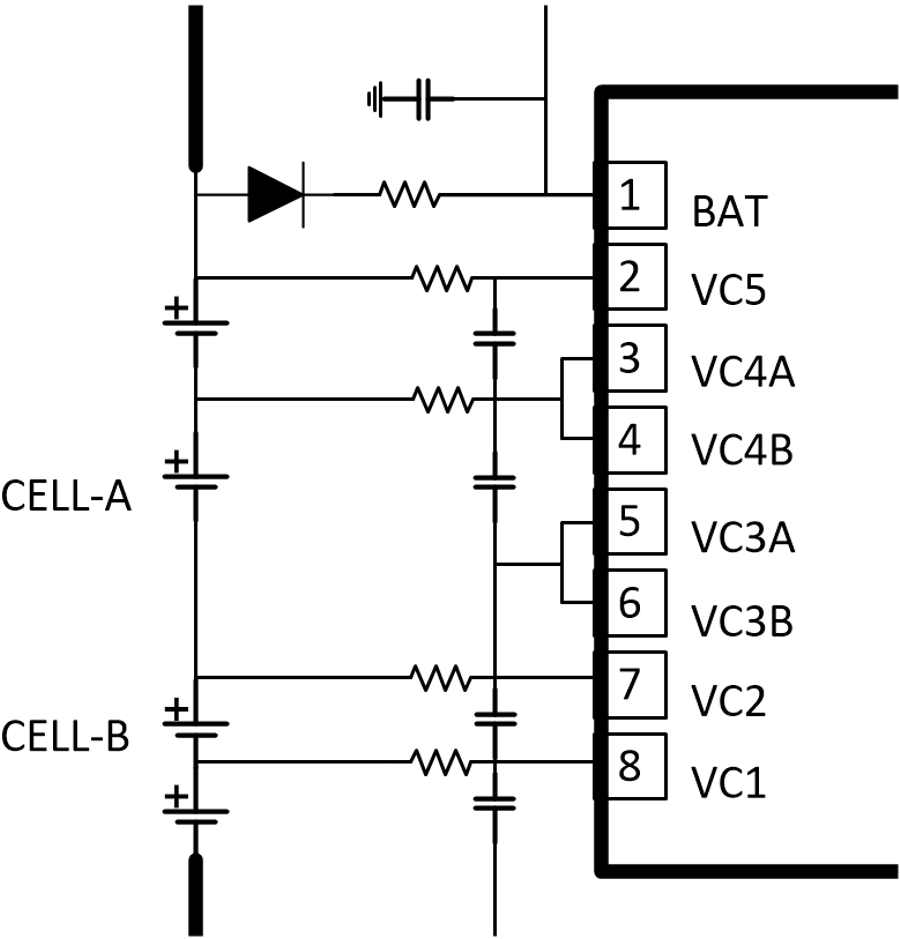ZHCSVT2A April 2022 – April 2024 BQ76922
PRODUCTION DATA
- 1
- 1 特性
- 2 应用
- 3 说明
- 4 Device Comparison Table
- 5 Pin Configuration and Functions
-
6 Specifications
- 6.1 Absolute Maximum Ratings
- 6.2 ESD Ratings
- 6.3 Recommended Operating Conditions
- 6.4 Thermal Information BQ76922
- 6.5 Supply Current
- 6.6 Digital I/O
- 6.7 LD Pin
- 6.8 Precharge (PCHG) and Predischarge (PDSG) FET Drive
- 6.9 FUSE Pin Functionality
- 6.10 REG18 LDO
- 6.11 REG0 Pre-regulator
- 6.12 REG1 LDO
- 6.13 Voltage References
- 6.14 Coulomb Counter
- 6.15 Coulomb Counter Digital Filter (CC1)
- 6.16 Current Measurement Digital Filter (CC2)
- 6.17 Current Wake Detector
- 6.18 Analog-to-Digital Converter
- 6.19 Cell Balancing
- 6.20 Cell Open Wire Detector
- 6.21 Internal Temperature Sensor
- 6.22 Thermistor Measurement
- 6.23 Internal Oscillators
- 6.24 High-side NFET Drivers
- 6.25 Comparator-Based Protection Subsystem
- 6.26 Timing Requirements – I2C Interface, 100kHz Mode
- 6.27 Timing Requirements – I2C Interface, 400kHz Mode
- 6.28 Timing Requirements – HDQ Interface
- 6.29 Interface Timing Diagrams
- 6.30 Typical Characteristics
-
7 Detailed Description
- 7.1 Overview
- 7.2 Functional Block Diagram
- 7.3 Diagnostics
- 7.4 Device Configuration
- 7.5
Measurement Subsystem
- 7.5.1 Voltage Measurement
- 7.5.2 General Purpose ADCIN Functionality
- 7.5.3 Coulomb Counter and Digital Filters
- 7.5.4 Synchronized Voltage and Current Measurement
- 7.5.5 Internal Temperature Measurement
- 7.5.6 Thermistor Temperature Measurement
- 7.5.7 Factory Trim of Voltage ADC
- 7.5.8 Voltage Calibration (ADC Measurements)
- 7.5.9 Voltage Calibration (COV and CUV Protections)
- 7.5.10 Current Calibration
- 7.5.11 Temperature Calibration
- 7.6 Primary and Secondary Protection Subsystems
- 7.7
Device
Hardware Features
- 7.7.1 Voltage References
- 7.7.2 ADC Multiplexer
- 7.7.3 LDOs
- 7.7.4 Standalone Versus Host Interface
- 7.7.5 Multifunction Pin Controls
- 7.7.6 RST_SHUT Pin Operation
- 7.7.7 CFETOFF, DFETOFF, and BOTHOFF Pin Functionality
- 7.7.8 ALERT Pin Operation
- 7.7.9 Fuse Drive
- 7.7.10 Cell Open Wire
- 7.7.11 Low Frequency Oscillator
- 7.7.12 High Frequency Oscillator
- 7.8 Device Functional Modes
- 7.9 Serial Communications Interface
- 7.10 Cell Balancing
- 8 Application and Implementation
- 9 Power Supply Requirements
- 10Layout
- 11Device and Documentation Support
- 12Revision History
- 13Mechanical, Packaging, Orderable Information
7.5.1.2 Using VC Pins for Cells Versus Interconnect
If the BQ76922 device is used in a system with fewer than 5-series cells, the additional cell inputs can be utilized to improve measurement performance. For example, a long connection may exist between two cells in a pack, such that there may be significant interconnect resistance between the cells, such as shown in Figure 7-1 between CELL-A and CELL-B. By connecting VC2 close to the positive terminal of CELL-B, and connecting VC3A/B close to the negative terminal of CELL-A, more accurate cell voltage measurements are obtained for CELL-A and CELL-B, since the I·R voltage across the interconnect resistance between the cells is not included in either cell voltage measurement. Since the device reports the voltage across the interconnect resistance and the synchronized current, the resistance of the interconnect between CELL-A and CELL-B can also be calculated and monitored during operation. It is recommended to include the series resistance and bypass capacitor on cell inputs connected in this manner, as shown below.
 Figure 7-1 Using Cell Input Pins for
Interconnect Measurement
Figure 7-1 Using Cell Input Pins for
Interconnect MeasurementIf this connection across an interconnect is not needed (or it is preferred to avoid the extra resistor and capacitor), then the unused cell input pins should be shorted to adjacent cell input pins, as shown in Figure 7-2 for VC3A/B.
 Figure 7-2 Terminating an Unused Cell
Input Pin
Figure 7-2 Terminating an Unused Cell
Input PinA configuration register is used to specify which cell inputs are used for actual cells. The device uses this information to disable cell voltage protections associated with inputs which are used to measure interconnect or are not used at all. Voltage measurements for all inputs are reported in 16-bit format (in units of mV) as well as 32-bit format (in units of raw ADC counts), irrespective of whether they are used for cells or not.